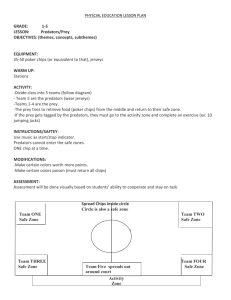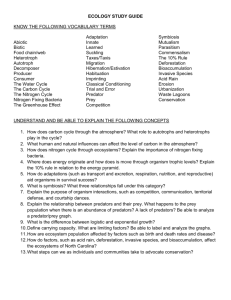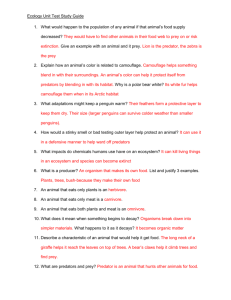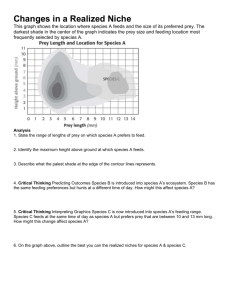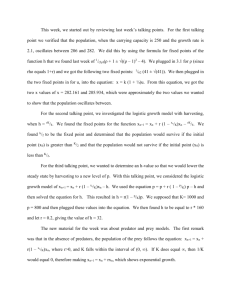Biology 423 – Exam # 1
advertisement
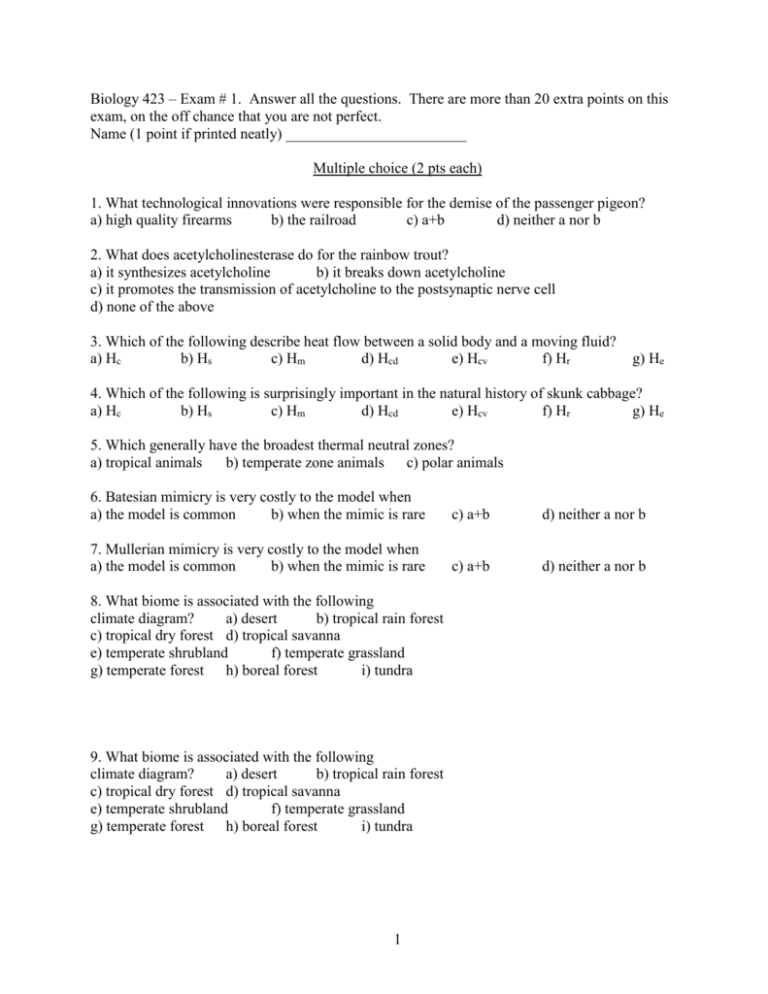
Biology 423 – Exam # 1. Answer all the questions. There are more than 20 extra points on this exam, on the off chance that you are not perfect. Name (1 point if printed neatly) ________________________ Multiple choice (2 pts each) 1. What technological innovations were responsible for the demise of the passenger pigeon? a) high quality firearms b) the railroad c) a+b d) neither a nor b 2. What does acetylcholinesterase do for the rainbow trout? a) it synthesizes acetylcholine b) it breaks down acetylcholine c) it promotes the transmission of acetylcholine to the postsynaptic nerve cell d) none of the above 3. Which of the following describe heat flow between a solid body and a moving fluid? a) Hc b) Hs c) Hm d) Hcd e) Hcv f) Hr g) He 4. Which of the following is surprisingly important in the natural history of skunk cabbage? a) Hc b) Hs c) Hm d) Hcd e) Hcv f) Hr g) He 5. Which generally have the broadest thermal neutral zones? a) tropical animals b) temperate zone animals c) polar animals 6. Batesian mimicry is very costly to the model when a) the model is common b) when the mimic is rare c) a+b d) neither a nor b 7. Mullerian mimicry is very costly to the model when a) the model is common b) when the mimic is rare c) a+b d) neither a nor b 8. What biome is associated with the following climate diagram? a) desert b) tropical rain forest c) tropical dry forest d) tropical savanna e) temperate shrubland f) temperate grassland g) temperate forest h) boreal forest i) tundra 9. What biome is associated with the following climate diagram? a) desert b) tropical rain forest c) tropical dry forest d) tropical savanna e) temperate shrubland f) temperate grassland g) temperate forest h) boreal forest i) tundra 1 10. Which of the following favors the evolution of hermaphroditism? a) high mobility b) high overlap in resource demands by female and male structures and functions c) a+b d) neither a nor b 11. Why do new males that take over a pride kill the existing lion cubs? a) to demonstrate to females their dominance b) because they need to replenish their food reserves after fighting with the previous males c) to bring the females into estrus d) none of the above 12. Eusocial insects do not have which of the following traits a) sterile castes b) cooperative care of young c) only one generation is alive at any one point in time d) all of the above are traits of eusocial insects. 13. Which is true of Tilman and Cowan's study on plants? a) shoot/root ratios decreased as soil nitrogen levels increased b) high nitrogen led to reduced investment in shoots c) a+b d) neither a nor b 14. Who is likely to have a lower degree of relatedness? a) you and your mother b) sisters in a eusocial ant colony c) naked mole rats 15. Where is it more likely that unrelated males will team up to form a coalition in lions? a) small group of males b) large group of males c) there is no correlation between male group size and degree of relatedness 16. What did Marshall’s research on radishes reveal? a) radishes mate randomly with each other b) there may be interference competition between pollen grains c) a+b d) neither a nor b 17. Randy Thornhill did the following: he put 12 male scorpionflies in an aquarium with 6 crickets. Six scorpionflies took the crickets and 6 scorpionflies exude saliva as a nuptial gift for the females. He then removed the 6 cricket takers. What happened to the 6 saliva exuders? a) they all became cricket owners b) they all remained saliva exuders c) some became cricket owners and some remained saliva exuders d) this never happened because no sane person would do this experiment 18. Which of the following treatments resulted in increased coloration in male guppies in Endler’s greenhouse experiment? a) pike cichlid b) Rivulus c) guppies only d) a+b e) a+c f) b+c g) all treatments resulted in increased male coloration 19. Which of the following is true about pumas? a) they are larger near the equator than they are near the arctic c) a+b d) neither a nor b 2 b) larger pumas eat larger prey 20. Pirt’s study on bioremediation with bacteria did which of the following? a) developed techniques for breaking down horse manure b) used thermophilic bacteria and bacteria active at 37 degrees c) converted almost all of the organic matter to water and oxygen d) none of the above 21. Which prediction of the prey choice model was supported by Krebs’s study on great tits? a) never ignore the highest ranking (in terms of profitability) prey b) less profitable prey should be ignored when its profitability is low c) animals should shift from random foraging to foraging on the more profitable prey at a specific encounter rate with the more profitable prey 22. Park’s study on water acquisition by plants indicated that a) Eleusine grew on coastal dunes but Digitaria didn’t b) Unwatered Eleusine’s mass increased more rapidly than Digitaria’s c) a+b d) neither a nor b 23. Which of the following is not true of Toolson’s study on cicadas? a) at 100% relative humidity, the cicada body temperature in an environmental chamber was equal to the air temperature b) water movement measured by sensors mounted above the cuticle increased at high temperatures c) the rate of water loss by Diceroprocta is among the lowest ever reported for a terrestrial insect d) plugging holes on the dorsal surface inhibited Diceroprocta from being able to cool itself 24. What is true about most marine bony fish? a) they are strongly hyperosmotic to the surrounding medium b) they tend to lose water across their gills c) they need to pump in extra sodium to their cells d) they have a very high quantity of urine 25. What do studies of thermoregulation reveal in relation to hummingbirds? a) hummingbird enter torpor when they arrive at breeding sites when flowers are abundant b) when nectar per flower increases from high visitation rates c) a+b d) neither a nor b 26. Which are true about desert-adapted plants? a) they have low values of Hcv to wind b) they have high values of Hcd from the ground c) they reduce Hr by orienting their leaves perpendicular to sunlight d) none of the above 27. Which is the top soil horizon? a) a b) b c) c d) o 28. Which has the highest human population density among tropical forests of Central America? a) rain b) wet c) moist d) dry 29. What type of ecological zone was modeled by Bruce Milne? a) ecotone b) lithosol c) caliche d) taiga e) tundra 3 30. Kerner’s transplant experiments in the Alps demonstrated which of the following: a) differences in growth form are morphological adjustments to environmental variation b) differences in growth form are due to genetic factors c) a+b d) neither a nor b 31. Studies by Case and Tracey on the chuckwalla, Sauromalus obesus show a) variation in winter rainfall increases with elevation b) Chuckwallas grow to larger size where winter rainfall is lower c) in a “common garden” both males and females from lower elevation populations are larger d) none of the above 32. Research by Carrol and Boyd on soapberry bugs indicates which of the following? a) there is an inverse relationship between fruit radius and beak length b) there is a genetic basis for differences in beak length c) a+b d) neither a nor b 33. Research on darters by Turner and Trexler indicate that a) large female darters produce fewer eggs b) darters that produce larger eggs lay fewer c) darters producing larger eggs have higher gene flow d) darters producing more eggs have less gene flow 34. Which of the following is inversely related? a) seed mass and seedling recruitment b) see mass and seedling dry mass c) seed mass and seedling height d) none of the above 35. Which has a higher degree of polymorphism? d) marine invertebrates a) reptiles b) birds c) rodents 36. Which type(s) of natural selection tend to increase variation within a population? a) disruptive selection b) directional selection c) a+b d) neither a nor b Short Answers 1. (5 points) Here are the population sizes over five generations: 100, 80, 10, 100, 90. a) What is the algebraic mean population size? b) What is the effective population size? 4 2. (10 points) You are doing research in the tropics and discover a new species of beetle which is found in two morphs. Morph 1 has enlarged mandibles that you discover is used in fighting. Morph 2 has normal sized mandibles. After months of research, you are able to show that these differences result from the action of 1 gene with normal mandibles being dominant over enlarged mandibles. Thus M is the allele for normal mandibles and m is the allele for large mandibles. Using advanced molecular technique you discover that in your population of 100 beetles, 61 are MM, 38 are Mm and 1 is mm. a) What are the genotype frequencies? b) What are the allele frequencies? c) Given the allele frequencies from (b) what would be the genotype frequencies under Hardy Weinberg equilibrium? d) Given that the population is not in Hardy Weinberg equilibrium, what would you investigate next about the beetles? 3. (5 pts) a) How many tropical insects are there according to Terry Erwin’s estimate? b) Describe in detail (include the math) the methods that Terry Erwin used to estimate the number of tropical insects? 5 4. (6 pts) a) How does a research project differ from a research program? b) Use any research program of your choosing to highlight how these two differ from each other. 5. (6 pts) When Likens and Bormann deforested part of Hubbard Brook Watershed, there were some interesting effects. In particular, (a) describe how the net output of Ca+, NH4, NO3 and S changed. (b) What are some possible explanations for these changes? (one of them we weren’t able to figure out in class). 6 6. (3 pts) Given the following values of , what is the water potential of fluids near the top of a tree? solutes = - 0.4 matric = -1.3 pressure= -2.2 air = - 55.0 7. (6 pts) Here are some temperature and precipitation data for two locations in the United States. For each location, predict the appropriate biome based on Neilson’s model Month Temp at A Jan. 3 Feb. 5 Mar. 8 Apr. 14 May 19 June 24 July 26 Aug. 25 Sep. 20 Oct. 15 Nov. 9 Dec. 6 Precip at A 70 90 110 110 90 80 80 75 90 95 100 80 Temp at B 15 17 20 24 28 30 31 30 27 22 18 16 Precip at B 100 150 200 50 30 20 15 10 20 30 50 150 A = _________________ B = _________________ 8. For each of the following, put an A if it refers to C3 photosynthesis, B if it refers to C4 photosynthesis, C if it refers to CAM photosynthesis, and a 0 if it refers to none of them. Some statements may have more than one correct answer. You get 1 point for each correct answer, and –1 point for each wrong answer. ______ carbon fixation occurs at night ______ Calvin cycle occurs in mesophll cells ______ uses PEP carboxylase ______ oxaloacetate is formed in bundle sheath cell 9. (4 pts) Imagine you spend your summers watching mongooses hunting snakes. You discover the following: The mongoose takes on average 90 minutes to find a snake. The handling time is 60 minutes (the snakes put up a very good fight). The mongoose get 1000 calories for each snake he subdues (on average). a) What value will the mongoose be maximizing with its behavior (I need a number for both a and b)? b) What is the profitability of snakes to mongooses? 7 10. (6 pts) In some species of birds, female egg production is almost unlimited, because they spend their mating season in an area that has tremendous amounts of food available to them. How might you expect the social behavior and morphology of males and females in these species to differ from the more usual pattern in birds? Name (8 points) ______________________ Ecology – Exam # 2 Please answer the following multiple choice questions. There is only one correct answer per question. There are many extra credit points embedded in the exam, so you can mess up a bit and still do fine (not that I’m recommending you mess up on purpose). 1. Honeyguides have a mutualistic interaction with a) humans b) bees c) bears d) raccoons e) none of these 2. In Nancy Johnson's study on mycorrhizae and the effects of fertilization, which plants had the highest flower production? a) plants without mycorrhizae b) plants with mycorrhizae from unfertilized soil c) plants with mycorrhizae from fertilized soil 3. Which of the following is true regarding the yucca/yucca moth mutualism? a) there is a negative correlation between number of eggs and flower retention b) intermediate number of oviposition scars has the highest level of flower retention c) a+b d) neither a nor b 4. Which of the following are fungal energy storage organs within root cortex cells? a) vesicles b) hyphae c) arbuscles 5. Research on darters by Turner and Trexler indicate that a) large female darters produce fewer eggs b) darters that produce larger eggs lay fewer c) darters producing larger eggs have higher gene flow d) darters producing more eggs have less gene flow 6. Which of the following is inversely related? 8 a) seed mass and seedling recruitment c) seed mass and seedling height b) seed mass and seedling dry mass d) none of the above 7. Which is associated with r-selection a) low value of rm c) slow development d) iteroparous reproduction b) weak competitive ability 8. Ruderals are dominant under conditions of a) low disturbance and low stress b) low disturbance and high stress c) high disturbance and low stress d) high disturbance and high stress 9. Regarding Bertschy and Fox’s study on pumpkinseed sunfish a) each population was a data point b) each species was a data point c) they did a comparison of two species in different environments 10. What was Peters’s recommendations regarding slash and burn agriculture? a) it should be banned because it is a significant contributor to air pollution and global warming b) it should be banned because it causes serious soil erosion c) long range efforts should be directed toward determining optimum cycles of slashing and burning d) none of the above 11. In the ant/aspen sunflower mutualism studied by Dan Janzen, did the sunflowers provide housing for the ants? a) always b) under restricted conditions c) never 12. Why do grasses easily establish themselves on the forest savannah border following a burn? a) because fierce winds dry the soil and make it less conducive to forest b) because annual fires keep trees from reestablishing themselves c) a+b d) neither a nor b 13. Which type of distribution pattern is typically observed in populations of plants and animals on a large scale? a) random b) regular (uniform) c) clumped d) all of the above e) none of the above 14. Which of the following species is most vulnerable to extinction? a) extensive geographic range, narrow habitat tolerance, and small local population b) restricted geographic range, narrow habitat tolerance, and small local population c) restricted geographic range, narrow habitat tolerance, and large local population d) extensive geographic range, narrow habitat tolerance, and large local population e) extensive geographic range, broad habitat tolerance, and large local population 15. If Ro = 0.8, what is the fate of the population? a) increase b) remain stable c) decrease d) become highly dynamic e) none of the above 16. The tunicate Thalia democratica shows what type of growth rate in response to phytoplankton blooms? a) geometric b) logistic c) exponential 17. Which of the following is a density independent factor? a) disease b) competition c) hurricanes d) all are density dependent 9 18. An index of dispersion of 1.0 would imply what type of distribution a) random b) regular (uniform) c) clumped 19. Which of the following is true? a) on a per unit area basis, extinction rates of molluscs, birds and mammals are higher on islands than on continents b) not taking area into account, extinction rates of molluscs, birds and mammals are higher on islands than on continents c) a+b d) neither a nor b 20. At carrying capacity, the birth rate of a species of bacteria = 2 per hour. What is the death rate? a) 2 per hour b) less than 2 per hour c) greater than 2 per hour d) need more information to answer this question 21. Which of the following is a reasonable graph of (k-N)/k vs. N? 22. Assuming that the carrying capacities of two competing species are somewhat different, which values of the competition coefficients are least likely to lead to stable coexistence? a) both = .01 b) both = 0.1 c) both = 1.0 d) both = 10 23. In Grant's study of character displacement in the Galapagos a) The beaks of Geospiza fortis are smaller on Santa Cruz, where it is sympatric with G. fuliginosa than on Daphne Major b) The beaks of G. fuliginosa are smaller on Santa Cruz, where it is sympatric with G. fortis, than on Los Hermanos c) a+b d) neither a nor b 24. Which of the following are true regarding Gause's experiments on paramecia? a) at full-strength food concentration, Paramecium aurelia declined but exclusion was not complete b) at half-strength food concentration P. aurelia was competitively excluded by P. caudatum c) a+b d) neither a nor b 25. Which of the following is true about the age distribution in Rwanda in comparison to Hungary? a) Rwanda has a much greater proportion of people in the prereproductive age classes b) Rwanda has a much greater proportion of people in the reproductive age classes c) Rwanda has a much greater proportion of people in the postreproductive age classes d) none of the above is true 26. What was assumed by the life-table study on mud turtles? a) the fertility rate is constant b) only females are produced c) a+b d) neither a nor b 27. In Joe Connel’s study of competition in barnacle a) in the upper intertidal, removing Balanus had a significant effect on survival by Chthamalus 10 b) In the middle intertidal, removing Balanus has no significant effect on survival by Chthamalus c) a+b d) neither a nor b 28. Which is a +/0 interaction? a) mutualism b) amensalism c) commensalism d) parasitism 29. The greatest variation in r among populations of Daphnia magma exposed to DCA was due to a) variation in concentration of DCA b) variation due to the genotype of Daphnia c) variation due to interaction between the genotype and the environment 30. After adjusting for body size, which group of animals lives at the highest population densities? a) aquatic invertebrates b) terrestrial invertebrates c) mammals d) birds e) vertebrate poikilotherms 31. What is true of creosote bushes? a) very young plants show a clumped distribution c) a+b d) neither a nor b b) mature plants show a regular distribution 32. What is true about swidden fires? a) they are intentionally set b) they have very little impact on temperature a few cm below the soil c) a+b d) neither a nor b 33. Which of the following is not an assumption of the logistic model a) effect of density on rate of increase is instantaneous b) environment is constant c) no immigration or emigration d) all of the above are assumptions of the logistic model 34. What assumptions were made by the demographic study on life-tables? a) that lx was constant from year to year b) that turtles are immortal c) a+b d) neither a nor b 35. What is true of snails in Rio Claro? a) the planktonic stage migrate slowly upstream b) the small snails drift downstream to the Pacific ocean after they metamorphose c) a+b d) neither a nor b 36. What is the most likely result of competition, under the conditions described by the following isocline graph? (assuming the initial population levels are represented by the *) a) species 1 goes extinct b) species 2 goes extinct c) stable equilibrium d) need more information 11 Short Answers 1. (8 points) Consider the following life table: Age 0-1 1-2 2-3 3-4 nx 1000 50 10 2 lx mx 0 10 50 100 a) Fill in the values for lx b) What is the value for the net reproductive rate (show your work). c) Will this population tend to increase, decrease, or remain the same? Why? d) What type of survivorship curve do these data represent? 2. (6 points) An ecology class decides to do a mark/recapture survey of grasshoppers at Selu Conservancy. Initially they capture, mark and release 200 grasshoppers. They come back the next day and capture 2000 grasshoppers, of which 10 are marked. a) What can they conclude about the number of grasshoppers in their study plot? b) List three assumptions they are making with these calculations. 12 3. (3 points) In a continuously breeding population of 100 whales, the birth rate was 0.9 per year, while the death rate was 0.8 per year. How many whales will there be in 20 years (please give your answer in terms of e - don't waste time trying to solve it all the way). 4. (6 points) Consider the following graph. a) At which point or points is dN/dt at a maximum? b) At which point or points is dN/dt closest to 0? c) At which point or points is dN/dt at a minimum? 5. (10 points) Given the following values, what will most likely happen if you start out with 10 individuals in species 1 and 10 individuals in species 2. You will need to draw the isoclines and the appropriate vectors. Explain your answer. K1= 100 K2 = 200 12 = 1 21 = 8 13 6. (3 points) Start with a population of 1000 individuals. How many individuals will you have in 3 generations if = 0.2? Name ________________________ Get it all right Be outasight Multiple choice – review 1. What technological innovations were responsible for the demise of the passenger pigeon? a) high quality firearms b) the railroad c) a+b d) neither a nor b 2. Which of the following is surprisingly important in the natural history of skunk cabbage? a) Hc b) Hs c) Hm d) Hcd e) Hcv f) Hr g) He 3. Mullerian mimicry is very costly to the model when a) the model is common b) when the mimic is rare c) a+b d) neither a nor b 4. Which of the following treatments resulted in increased coloration in male guppies in Endler’s greenhouse experiment? a) pike cichlid b) Rivulus c) guppies only d) a+b e) a+c f) b+c g) all treatments resulted in increased male coloration 5. Which of the following is not true of Toolson’s study on cicadas? a) at 100% relative humidity, the cicada body temperature in an environmental chamber was equal to the air temperature b) water movement measured by sensors mounted above the cuticle increased at high temperatures c) the rate of water loss by Diceroprocta is among the lowest ever reported for a terrestrial insect d) plugging holes on the dorsal surface inhibited Diceroprocta from being able to cool itself 6. Research by Carrol and Boyd on soapberry bugs indicates which of the following? a) there is an inverse relationship between fruit radius and beak length 14 b) there is a genetic basis for differences in beak length c) a+b d) neither a nor b 7. Which type(s) of natural selection tend to increase variation within a population? a) disruptive selection b) directional selection c) a+b d) neither a nor b 8. In Nancy Johnson's study on mycorrhizae and the effects of fertilization, which plants had the highest flower production? a) plants without mycorrhizae b) plants with mycorrhizae from unfertilized soil c) plants with mycorrhizae from fertilized soil 9. Which of the following is true regarding the yucca/yucca moth mutualism? a) there is a negative correlation between number of eggs and flower retention b) intermediate number of oviposition scars has the highest level of flower retention c) a+b d) neither a nor b 10. Which is associated with r-selection a) low value of rm b) weak competitive ability c) slow development d) iteroparous reproduction 11. Which type of distribution pattern is typically observed in populations of plants and animals on a large scale? a) random b) regular (uniform) c) clumped d) all of the above e) none of the above 12. Which of the following species is most vulnerable to extinction? a) extensive geographic range, narrow habitat tolerance, and small local population b) restricted geographic range, narrow habitat tolerance, and small local population c) restricted geographic range, narrow habitat tolerance, and large local population d) extensive geographic range, narrow habitat tolerance, and large local population e) extensive geographic range, broad habitat tolerance, and large local population 13. In Grant's study of character displacement in the Galapagos a) The beaks of Geospiza fortis are smaller on Santa Cruz, where it is sympatric with G. fuliginosa than on Daphne Major b) The beaks of G. fuliginosa are smaller on Santa Cruz, where it is sympatric with G. fortis, than on Los Hermanos c) a+b d) neither a nor b 14. In Joe Connel’s study of competition in barnacle a) in the upper intertidal, removing Balanus had a significant effect on survival by Chthamalus b) In the middle intertidal, removing Balanus has no significant effect on survival by Chthamalus c) a+b d) neither a nor b 15. What is true about swidden fires? a) they are intentionally set b) they have very little impact on temperature a few cm below the soil c) a+b d) neither a nor b Multiple choice – new material 15 1. According to Vitousek, human sources of fixed nitrogen exceeded nonhuman sources of fixed nitrogen for the first time a) late in the 20th century b) early in the 20th century c) during the industrial revolution d) during the agricultural revolution 2. Which of the following is true about forests in Brazil? a) considering the edge effect actually reduces estimates of the amount of deforestation that has occurred b) Brazil has more rain forest than any other country c) a+b d) neither a nor b 3. What did Gause need in order to get predator prey oscillations in his Paramecia populations? a) refuges b) immigration from source populations c) a+b d) neither a nor b 4. Which of the following is evidence that human industrial activity is at the heart of recent increases in CO2 in the atmosphere? a) In recent history, disruption in global economic activity correspond to interruptions in the CO2 increase b) there has been a recent increase in the level of 14C in the atmosphere c) a+b d) neither a nor b 5. The presence of the protozoan parasite Adelina tribolii affects flour beetle competition in what way? a) in the presence of Adelina T. castaneum usually outcompetes T. confusum b) it has no impact on the competitive balance, but does affect the time the beetles take to mature c) in the presence of Adelina T. confusum usually outcompetes T. castaneum d) in the presence of Adelina, Morgan King usually outcompetes both species 6. What is true about the interaction of the prickly pear cactus (Opuntia) and the moth (Cactoblastis) in Australia? a) there is evidence for a prolonged evolutionary arms race between these two species in Australia b) there is a cyclic equilibrium between these two species c) a+b d) neither a nor b 7. Approximately 25% of all species are parasitoids. A) true b) false 8. What did Williams’s study on periodical cicadas show? a) predation by birds was highest when cicada density was highest b) predator satiation c) a+b d) neither a nor b 9. Procambarus’s effect on schistosomiasis is via what mechanism? a) it eats the circariae b) it eats the eggs c) it eats the flukes d) it eats the snails 10. What type of functional response is shown by Daphnia feeding on yeast? a) I b) II c) III 11.Which of the following describes the cyclamen mite that infects strawberries 16 a) it has difficulty dispersing b) it has a low reproductive rate c) it doesn’t need to eat very much d) none of the above 12. AIDS has been very successful spreading in human populations. Linda Fuselier described a model of disease spread. For which variable in her model did AIDS not have a consistently large value? a) number of susceptible hosts in the population b) transmission rate c) % of infected individuals that survive long enough to spread the disease d) average time infected host remains infectious 13. Species A has a 15N value of +11.2. Species B has a 15n value of 12.7. What would be a plausible conclusion? a) Species A eats species B, but also eats something one trophic level lower in the food web b) Species B eats species A, but also eats something one trophic level lower in the food web c) both are highly plausible d) neither are highly plausible 14. Which was quicker to recover following the Mt. St. Helens explosion? a) species richness b) % cover c) both recovered at an equal rate 15. Which of the following is true of the rescue effect described by the Browns? a) it is greater when islands are close to a source pool b) it tends to reduce extinction rates c) a+b d) neither a nor b 16. Why are z-values from continental islands usually lower than z-values from oceanic islands? a) because a disproportionate number of transients are attracted to oceanic islands b) because richness increases more slowly with area in oceanic islands c) a+b d) neither a nor b 17. Species richness is still increasing at Krakatau. a) true b) it has reached equilibrium c) it is actually declining 18. Ichneumonid wasp species richness is greatest a) near the equator b) at middle latitudes c) at high latitudes 19. A much higher percentage of tree genera have become extinct in a) Europe b) eastern North America c) Asia 20. Which of the following are strong interactions in Tscharntke’s study of trophic interactions associated with Phragmites? a) blue tits negatively affect the fly, G. inclusa and its parasitoids b) G. inclusa attacks the parasitoids Aprostocetus gratus and Platygaster quadrifarius c) a+b d) neither a nor b 21. Jane Lubchenko’s study of the effect of the snail Littorina littorea on algal communities shows which of the following to be true? a) adding Littorina to a tide pool that had few of the snails increased Enteromorpha cover b) removing Littorina from a tide pool where it had been abundant reduced Enteromorpha cover c) a+b d) neither a nor b 17 22. Mary Power’s experiment in which she enclosed fish within cages in the Eel River demonstrated which of the following? a) enclosing fish led to increased densities of predatory insects b) enclosing fish led to decreased densities of herbivorous chironomids c) a+b d) neither a nor b 23. What Paine removed the starfish Pisaster from his food web, what happened? a) there was a rapid sharp increase in the barnacle Balanus glandula b) species richness increased c) a+b d) neither a nor b 24. Species that have significant influence on community structure by virtue of high biomass are known as a) dominant species b) keystone species c) indicator species 25. Which are true of Oecophylla (the citrus ant)? a) the ants are actually ineffective for biological control, because they increase the populations of the smaller pests of citrus (such as the soft-scale insects). b) the ants have been used for 1700 years by farmers in Southern China c) a+b d) neither a nor b 26. What is the effect of the fire ant, Solenopsis, on corn? a) it increases the number of individuals of arthropods by killing the predators b) it increases the number of species of herbivores by killing the predators c) a+b d) neither a nor b 27. As food webs increase in complexity, the proportion of predatory species a) increases b) decreases c) remains the same 28. Which conclusions are justified from Atlegrim's study of the effects of bird predation on plants? a) birds do not reduce the density of insect larvae feeding on Vaccinium b) Torticid larvae are particularly vulnerable to bird predation c) Vaccinium that were protected from birds had higher levels of damage d) none of the above 29. Which of the following is true a) there is an inverse relationship between terrestrial primary production and actual evapotranspiration rate b) there is an inverse relationship between primary production in grasslands and annual precipitation c) a+b d) neither a nor b 30. The amount of energy left over after autotrophs have met their own energetic needs is a) energy surplus b) energy flow c) gross primary production d) net primary production 31. Which nutrient is the primary limiting factor of phytoplankton biomass in North American lakes? a) nitrogen b) phosphorus c) iron d) potassium 18 32. If you were to compare a trophic cascade with 3 species (cascade A) to a trophic cascade with 5 species (cascade B), which of the following would probably be true? a) removing the top predator will increase the abundance of the producer in both cascades b) removing the top predator will increase the abundance of the producer in cascade A c) removing the top predator will increase the abundance of the producer in cascade B d) none of the above is true 33. Graneli’s study of marine ecosystems indicated which nutrient limits productivity? a) nitrogen b) phosphorus c) iron d) potassium 34. Which Serengeti grasslands have the highest primary productions a) grasslands with low intensity grazing b) grasslands with medium intensity grazing c) grasslands with high intensity grazing 35. Stable isotope analysis done by Person et al studied feeding behavior of the ribbed mussel, Geukinsia demissa. Which of the following are true? a) in the interior of the marsh the mussel feeds mainly on Spartina b) near the mouth of the marsh, the mussel feeds mainly on plankton c) a+b d) neither a nor b 36. If you were to compare the energy flowing through the Hubbard Brook forest ecosystem you would find a) most is lost as heat b) most is used to power evapotranspiration c) the amount of energy lost as heat and used to power evapotranspiration is very similar 37. Why is phosphorus needed by living organisms? a) to make cell membranes b) to make nucleic acids c) a+b d) neither a nor b 38. Grimm's study of nutrient retentiveness showed that nitrogen ingestion rates by macroinvertebrates averaged 131%. How could this possibly be? a) her measures were later shown to be incorrect (by Lindemann) b) nitrogen was constantly being added to the stream by runoff from farms and ranches c) macroinvertebrates eat their poop d) none of the above 39. Melilo et al used litter bags to study decomposition in New Hampshire and North Carolina temperate forests. They discovered that a) leaves with more lignin lost more mass b) leaf mass remaining was lower in New Hampshire c) leaves with a relatively low concentration of nitrogen lost mass at a lower rate d) none of the above 40. Vitousek’s study on changes in nitrogen within forested ecosystems (the trench study) indicated which of the following? a) NH3 losses occurred first b) NO3 losses occurred first c) NH3 gains occurred first d) NO3 gains occurred first 41. Why did Vitousek leave plants to decompose on his study plots? 19 a) to prevent plant uptake of nutrients and water b) to preserve the forest canopy c) to interrupt plant nitrogen uptake without decreasing nitrogen input d) all of the above 42. Which type of land use is most associated with phosphorus expert from stream basins? a) forest b) urban c) agriculture 43. The late (and often stable) successional community is called a) primary succession b) secondary succession c) tertiary succession d) climax 44. The lower vulnerability shown by early successional species of algae (Sousa's study) supports which model of succession? a) facilitation b) tolerance c) inhibition 45. Four stages of succession occur in the Glacier Bay ecosystem: they are Spruce, Dryas, Alder and Pioneer. Which is the second stage? a) spruce b) Dryas c) Alder d) pioneer 46. For which model of succession is there the least supporting evidence? a) facilitation b) tolerance c) inhibition 47. After floods in Syacamore Creek, which were the first colonists in Fisher’s study? a) green algae (Cladophora) b) blue-green algae c) diatoms 48. Diamond's study of birds on the Channel Islands revealed a) the number of bird species remained almost constant on each island b) there was extensive species turnover c) a+b d) neither a nor b 49. Mary Jane Perry used remote sensing to study a) burning of tropical rain forests b) patterns of species richness in relation to latitude c) patchiness of phytoplankton in the ocean d) none of these 50. Which of the following was done by Dan Simberloff? a) fumigating islands to eliminate all animal life b) removing parts of islands to reduce area c) a+b d) neither a nor b Short Answers Questions 1 and 2 are based on the graph below: 20 1. (2 pts) Show the point on the X-axis (your point must be on the X-axis) that corresponds to the equilibrium species richness of a small island that is distant from shore. 2. (4 pts) Each curve is labeled A, B, C, D. What do these labels correspond to? A____________________________________________ B____________________________________________ C____________________________________________ D____________________________________________ 3. (8 pts) Answer the questions based on the following food web (Show your work): a) How many trophic levels are there? b) What is the connectance? 21 c) What is the linkage density? 4. (8 pts) Draw the predator/prey graph (with isoclines) when the following hold: r = 2, a = 0.1, c= 0.05, q= 0.2 Answer questions 5-7 based on the graph you just made (2 pts each). 5. What will happen to the population if N= 10 and C = 30? a) prey will increase, predators will increase b) prey will increase, predators will decrease c) prey will decrease, predators will increase d) prey will decrease, predators will decrease e) no change 22 6. What will happen to the population if N =50 and C =30? a) prey will increase, predators will increase b) prey will increase, predators will decrease c) prey will decrease, predators will increase d) prey will decrease, predators will decrease e) no change 7. What will happen to the population if N =40 and C =20? a) prey will increase, predators will increase b) prey will increase, predators will decrease c) prey will decrease, predators will increase d) prey will decrease, predators will decrease e) no change 8. (4 pts) In the following ecosystem, what percentage of the energy that is inputted into producers is actually passed on to the tertiary consumers? 9. (10 points) Given the following values, what will most likely happen if you start out with 40 individuals in species 1 and 10 individuals in species 2. You will need to draw the isoclines and the appropriate vectors. Explain your answer. K1= 50 K2 = 100 12 = .1 21 = .5 23 10. (5 points) Here are the population sizes over five generations: 100, 50, 10, 20, 100. a) What is the algebraic mean population size? b) What is the effective population size? 24



